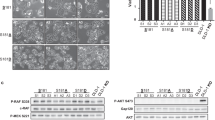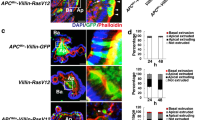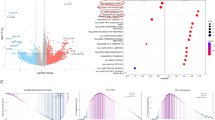Abstract
DNAs of some human tumours can transform NIH 3T3 fibroblast cells1–7, thus demonstrating the transforming potential of human ras genes (Hu-rasHa, Hu-rasKi, and Hu-rasN, respectively Harvey, Kirsten and neurohlastoma ras genes). Only a small percentage of a given type of human carcinoma, however, scores positive in this assay system8–10. Activation of ras and subsequent transformation of NIH 3T3 cells are either by a point mutation in the ras gene11–18 or enhanced expression of the normal, or proto-onc, ras gene19–21. If the transformation of a given human tumour involves the enhanced expression of the normal or cellular ras gene and the resulting gene product, the tumour DNA would probably score negative in the NIH 3T3 transfection assay. In human colon carcinoma, for example, lesions at position 12 of Hu-rasKi have been found8,21. None of nine colon carcinomas obtained at biopsy, however, contain the ras lesion at this position, using a Hu-rasHa probe22; one other colon carcinoma does appear to contain amplified proto–onc ras21, and other colon carcinomas do have increased levels of ras RNA23. There are at least three explanations for these observations. Either very few colon carcinomas contain point-mutated ras, the lesion in the majority of colon carcinomas is at a position other than 12, or ras activation in many colon carcinomas involves the enhanced expression of either the point-mutated or proto-onc form of a ras gene. We have now used monoclonal antibodies directed against a synthetic peptide reflecting sequences of the human T24 ras gene product to define ras p21 protein expression in a spectrum of colonie disease states. Immunohistochemical analyses of individual cells within tissue sections reveal differences in ras p21 expression in colon carcinomas compared with normal colonie epithelium, benign colon tumours and inflammatory or dysplastic colon lesions. Our data suggest that ras p21 expression is correlated with depth of carcinoma within the bowel wall, and is probably a relatively late event in colon carcinogenesis.
This is a preview of subscription content, access via your institution
Access options
Subscribe to this journal
Receive 51 print issues and online access
$199.00 per year
only $3.90 per issue
Buy this article
- Purchase on SpringerLink
- Instant access to full article PDF
Prices may be subject to local taxes which are calculated during checkout
Similar content being viewed by others
References
Pulciani, S. Proc. natn. Acad. Sci. U.S.A. 79, 2845–2849 (1982).
Parada, L. F., Tabin, C. J., Shih, C. & Weinberg, R. A. Nature 297, 474–478 (1982).
Shimizu, K. et al. Proc. natn. Acad. Sci. U.S.A. 80, 2112–2116 (1983).
Hall, A., Marshall, C. J., Spurr, N. K. & Weiss, R. A. Nature 303, 396–400 (1983).
Shimizu, K., Goldfarb, M., Perucho, M. & Wigler, M. Proc. natn. Acad. Sci. U.S.A. 80, 383–387 (1983).
Der, C., Krontiris, T. & Cooper, G. Proc. natn. Acad. Sci. U.S.A. 79, 3637–3640 (1982).
Shih, C. & Weinberg, R. A. Cell 29, 161–169 (1982).
Pulciani, S. et al. Nature 300, 539–542 (1982).
Feig, L. A., Bast, R. A. Jr, Knapp, R. C. & Cooper, G. M. Science 223, 698–700 (1984).
Land, H., Parada, L. F. & Weinberg, R. A. Science 222, 771–777 (1983).
Santos, E., Tronick, S. R., Aaronson, S. A., Pulciani, S. & Barbacid, M. Nature 298, 343–347 (1982).
Nakano, H. et al. Proc. natn. Acad. Sci. U.S.A. 81, 71–75 (1984).
Capon, D. J. et al. Nature 304, 507–513 (1983).
Der, C. J. & Cooper, G. M. Cell 32, 201–208 (1983).
Tabin, C. J. et al. Nature 300, 142–148 (1982).
Santos, E. et al. Science 223, 661–669 (1984).
Taparowsky, E. et al. Nature 300, 762–765 (1982).
Reddy, E. P., Reynolds, R. K., Santos, E. & Barbacid, M. Nature 300, 149–152 (1982).
Chang, E. H., Furth, M. E., Scolnick, E. M. & Lowy, D. R. Nature 297, 479–483 (1982).
DeFeo, D. et al. Proc. natn. Acad. Sci. U.S.A. 78, 3328–3332 (1981).
McCoy, M. S. et al. Nature 302, 79–81 (1983).
Feinberg, A. P., Vogelstein, B., Droller, M. J., Baylin, S. B. & Nelkin, B. D. Science 220, 1175–1177 (1983).
Slamon, D. J., deKernion, J. B., Verma, I. M. & Cline, M. J. Science 224, 256–262 (1984).
Horan Hand, P. et al. Proc. natn. Acad. Sci. U.S.A. 81, 5227–5231 (1984).
Sukumar, S., Notario, V., Martin-Zanca, D. & Barbacid, M. Nature 306, 658–661 (1983).
Cho-Chung, Y. S. & Huang, F. L. in Proc. 16th Miami Winter Symp., 142–143 (ICSU Press, Miami, 1984).
Wierenga, R. K. & Hol, W. G. J. Nature 302, 842–844 (1983).
Pincus, M. R. et al. Proc. natn. Acad. Sci. U.S.A. 80, 5253–5257 (1983).
Muto, T., Bussey, H. R. J. & Morson, B. C. Cancer 36, 2251–2270 (1975).
DeVita, V. T. Jr, Hellman, S. & Rosenberg, S. A. Cancer: Principles and Practice of Oncology, 647–650 (Lippincott, Philadelphia, 1982).
Spratt, J. S., Ackerman, L. V. & Moyer, C. A. Ann. Surg. 148, 682–698 (1958).
Castleman, B. & Krickstein, H. I. New Engl. J. Med. 267, 469–475 (1962).
Fung, C. H. K. & Goldman, H. Am. J. clin. Path. 53, 21–25 (1970).
Shih, T. Y. & Weeks, M. O. Cancer Invest. 2, 109–123 (1984).
Horan Hand, P., Nuti, M., Colcher, D. & Schlom, J. Cancer Res. 43, 728–735 (1983).
Albino, A. P., LeStrange, R., Oliff, A. I., Furth, M. E. & Old, L. J. Nature 308, 69–72 (1984).
Kufe, D. W. et al. Cancer Res. 43, 851–857 (1983).
Campisi, J., Gray, H. E., Pardee, A. B., Dean, M. & Sonenshein, G. E. Cell 36, 241–247 (1984).
Spratt, J. S. & Ackerman, L. V. Am. Surg. 27, 23–28 (1961).
Welin, S., Youker, J. & Spratt, J. S. Am. J. Roentgenol., Radium Ther. nucl. Med. 90, 673–687 (1963).
Bussey, H. J. R. Familial Polyposis Coli (Johns Hopkins University Press, Baltimore, 1975).
Edwards, F. C. & Truelove, S. C. Gut 5, 15–22 (1964).
DeVita, V. T., Jr, Hellman, S. & Rosenberg, S. A. Cancer: Principles and Practice of Oncology, 674–675 (Lippincott, Philadelphia, 1982).
Land, H., Parada, L. F. & Weinberg, R. A. Nature 304, 596–602 (1983).
Needleman, S. W., Yuasa, Y., Srivastava, S. & Aaronson, S. A. Science 222, 173–175 (1983).
Dukes, C. E. J. Path. Bact. 50, 527–539 (1940).
Cass, A. W., Million, R. R. & Pfatt, W. W. Cancer 37, 2861–2865 (1976).
Molson, B. C. & Dawson, I. M. P. Gastrointestinal Pathology, 664–665 (Blackwell, Oxford, 1979).
Nuti, M. et al. Int. J. Cancer 29, 539–545 (1982).
Hsu, S-M., Raine, L. & Fanger, H. J. Histochem. Cytol. 29, 577–580 (1981).
Colcher, D. et al. Cancer Res. 43, 736–742 (1983).
Potter, M. Physiol. Rev. 631–719 (1972).
Author information
Authors and Affiliations
Rights and permissions
About this article
Cite this article
Thor, A., Hand, P., Wunderlich, D. et al. Monoclonal antibodies define differential ras gene expression in malignant and benign colonic diseases. Nature 311, 562–565 (1984). https://doi.org/10.1038/311562a0
Received:
Accepted:
Issue date:
DOI: https://doi.org/10.1038/311562a0
This article is cited by
-
Anti-colorectal cancer effects of anti-p21Ras scFv delivered by the recombinant adenovirus KGHV500 and cytokine-induced killer cells
BMC Cancer (2018)
-
Microallelotyping defines the sequence and tempo of alleiic losses at tumour suppressor gene loci during colorectal cancer progression
Nature Medicine (1995)
-
Neuroblastoma stage Iv-S
Medical Oncology (1994)
-
ras and c-myc protein expression in colorectal carcinoma
Diseases of the Colon & Rectum (1992)
-
Oncogene proteins as biomarkers in the molecular epidemiology of occupational carcinogenesis
International Archives of Occupational and Environmental Health (1991)



